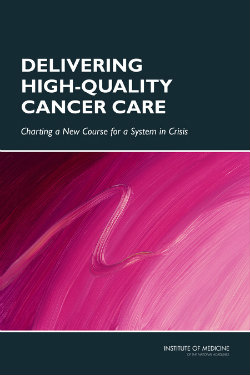 The Institute of Medicine (IOM) is swinging for the fences with the release of a new report, Delivering High-Quality Cancer Care: Charting a New Course for a System in Crisis.
The Institute of Medicine (IOM) is swinging for the fences with the release of a new report, Delivering High-Quality Cancer Care: Charting a New Course for a System in Crisis.
The report makes recommendations in six areas critical to the delivery of quality cancer care:
- Engaged patients
- An adequately staffed, trained, and coordinated workforce
- Evidence-based care
- Learning health care information technology (IT)
- Translation of evidence into clinical practice, quality measurement, and performance improvement
- Accessible and affordable care.
Yes! Yes! Engaged patients are the first priority spotlighted by the IOM. What you will also find in this seminal report is attention to quality of life and palliative care. My heart soars just typing these words.
As a person living with stage IV cancer—and an advocate for both person-centered care and the field of palliative care—this report represents a fundamental shift from cancer care being measured solely in terms of three-month increments of length of life to one that recognizes this is not the only goal.
It’s not my goal. (For more on this, read two of my previous blog post: Can Good Care Produce Bad Health and Health Affairs Focuses on Cancer.)
It should be no surprise that I provided testimony, served as a reviewer for the report, and am included speaking about palliative care in the accompanying IOM video clip, which you can watch below.
https://www.youtube.com/watch?v=1wJYCQATh90
The full video is 22 minutes, and I encourage you to watch the whole thing. The IOM also has broken it into 13 clips if you prefer viewing it that way.
The IOM has broken new ground by stating clearly that cancer is primarily a disease associated with aging, something the John A. Hartford Foundation has long recognized through our support of geriatric oncology fellowships and curricula through grants to the American Society for Clinical Oncology (ASCO). Arti Hurria, director of City of Hope’s Cancer and Aging Research Program and a member of the IOM study section, was a recipient of this fellowship. Another member of this IOM committee was Harvey Cohen, director of the Hartford Center of Excellence at Duke University Medical Center.
Here’s what the report says about the connection between cancer and aging:
Cancer care for older adults … is especially complex. Age is one of the strongest risk factors for cancer, and there are many important considerations to understanding older adults with cancers’ prognoses and formulating their care plans, such as altered physiology, functional and cognitive impairment, multiple coexisting morbidities, increased side effects to treatment, distinct goals of care, and the increased importance of social support. The current health care delivery system is poorly prepared to address these concerns comprehensively. Thus, addressing the needs of the aging population will be an integral part of improving the quality of cancer care.
 Amy Berman on the day she testified before the the IOM committee that prepared the report.
Amy Berman on the day she testified before the the IOM committee that prepared the report.The IOM and the Hartford Foundation both recognize that two-thirds of oncology patients today are ages 65 and older. The projections loom large with the older adult population expected to double by 2030 leading to 45 percent increase in people developing cancer. Despite the demographic shift, cancer care—until now—has largely ignored the unique and complex needs of older people and families living with cancer.
The problems are many. Clinical training has failed to adequately address the quality and quantity of our health care workforce. Evidence about care and treatment is based on research that has often excluded the older adult population. Perhaps most egregious, people are not actively engaged in decisions about their own care. As a result, care may not fit with their values and goals.
The societal costs range from poor quality of life and poor outcomes to untenably high costs. The cost of cancer care has been on a steep incline rising faster than many other areas of health care. Over a six-year period starting in 2004, cancer care spending increased from $72 billion to $125 billion. And it is projected to reach $173 billion by 2020.
Delivering High-Quality Cancer Care: Charting a New Course for a System in Crisis makes major strides by reframing the problem and providing bold recommendations that, I believe, can markedly lower the cost and raise the quality of cancer care.
Editor's Note: This is the latest in a series of Health AGEnda blog posts by Amy Berman chronicling her health and care since she was diagnosed with Stage IV inflammatory breast cancer. For earlier posts, please read:
Expecting Great Beginnings—and Endings
Transparency and the Teachable Moment
The Essential (Before I Kick the) Bucket List
Health Affairs Focuses on Cancer
Think Silver-Not Pink-for Breast Cancer Awareness Month
